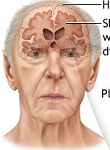|
|
|
Potential Models of Late-onset Alzheimer’s Disease
|
|
|
|
|
|
|
|
|
|

|
|
|
Holly M. Brothers, Ph.D.
|
|
|
|
The Ohio State University
|
|
Department of Psychology, OSU, Columbus, OH 43210
|
|
brothers.23@osu.edu
|
|
|
|
|
|
|
|
|
|

|
|
Alzheimer’s disease (AD) is a devastating illness with unknown etiology and no cure. The predominant model for studying AD has been transgenic mice with human mutant amyloid-ß (Aß) protein designed to reflect inherited familial forms of AD (fAD). However, this approach only reflects a small percentage of the AD population and has not lead to successful therapeutics. There is recent and compelling evidence that the Aß is not simply a misfolded protein that accumulates to eventual AD, but instead a protein with physiological roles that responds to several pathological contexts. If we better understand the contexts that stimulate Aß accumulation, and the character of its response, we can refocus research on targets upstream of Aß. In order to do this, the field needs models of late-onset AD (LOAD) that do not rely on human transgenes in mice. This perspective outlines models of contextually-driven Aß accumulation, animals with naturally elevated Aß and a potential human organ model that may be employed to better understand the role of Aß in AD.
|
|
|
|
|
|
|
|

|
|